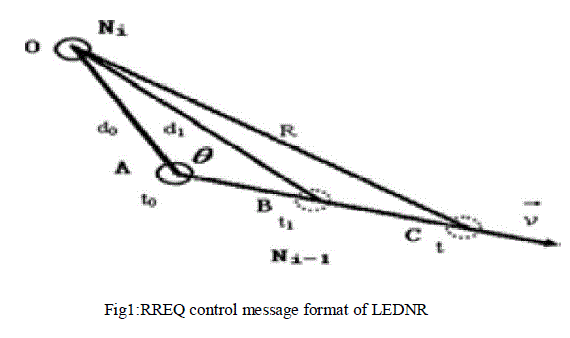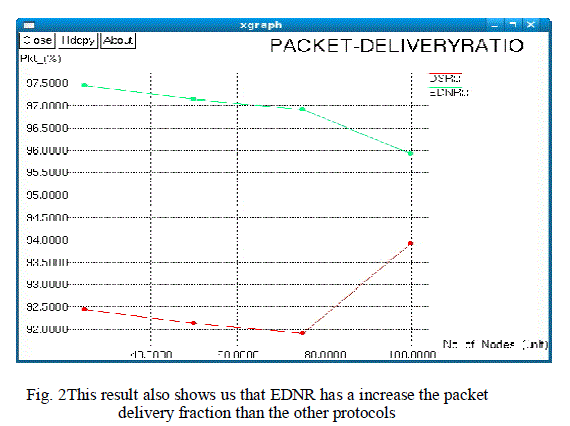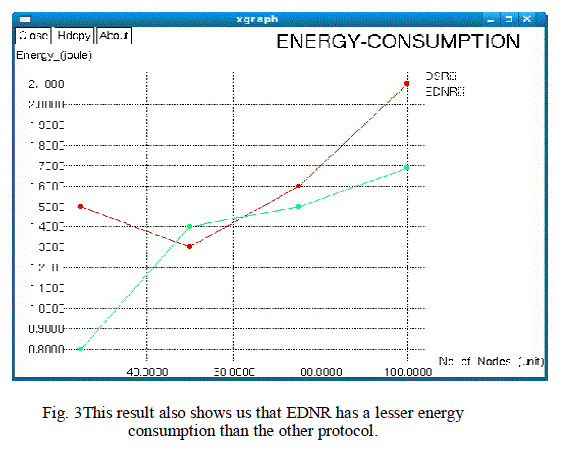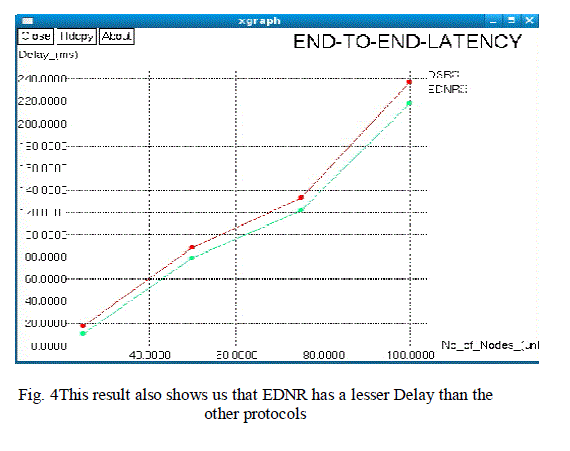ISSN ONLINE(2319-8753)PRINT(2347-6710)
ISSN ONLINE(2319-8753)PRINT(2347-6710)
Pavithra.R1, Pavithra.V2, Santhosh.A.K3, Natraj.N.A4
|
| Related article at Pubmed, Scholar Google |
Visit for more related articles at International Journal of Innovative Research in Science, Engineering and Technology
In mobile ad-hoc network (MANET), a host may exhaust its power or move away without giving any notice to its cooperative nodes. It causes changes in network topology, and thus, it significantly degrades the performance of a routing protocol. Several routing protocol studies are based on node lifetime and link lifetime. The main objective here is to evaluate the node lifetime and the link lifetime utilizing the dynamic nature, such as the energy drain rate and the relative mobility estimation rate of nodes. These two performance metrics are integrated by Route lifetime-prediction algorithm. This algorithm is carried out as follows1) Select the least dynamic route with the longest lifetime for persistent data forwarding.2) Node Lifetime and link lifetime prediction methods. The exponentially weighted moving average method is used to estimate the energy drain rate. The receiver can measure the signal strength when it receives the packets from sender in same power level and then it calculates the distance between two nodes by applying the radio propagation model.The EDNR protocol outperforms the conventional DSR protocols that are implemented with lifetime-prediction routing (LPR) and signalstability- based adaptive (SSA) routing mechanisms and it is simulated using NS2.
Keywords |
| Mobile ad hoc networks (MANETs), node lifetime, route discovery, Proactive/Reactive routing protocol, performance analysis. |
INTRODUCTION |
| A mobile ad hoc network (MANET) consists of many mobile nodes that can communicate with each other directly or through intermediate nodes. Often, hosts in a MANET operate with batteries and can roam freely, and thus, a host may exhaust its power or move away, giving no notice to its neighboring nodes, causing changes in network topology. A key characteristic of these scenarios is the dynamic behaviour of the involved communication partners. |
| Communication protocols will have to deal with a frequently changing network topology. However, many applications require stable connections to guarantee a certain degree of QoS(Quality of service). In access networks, access point handovers may disrupt the data transfer. In addition, service contexts may need to be transferred to the new access points, introducing additional overhead and delays to the connection. In ad hoc networks, mobile services enable peer-to-peer connections for voice or data traffic. Using stable links is crucial for establishing stable paths between connection peers. Rerouting is especially costly in these networks without infrastructure, since it usually results in (at least partly) flooding the network. The stabilityof a link is given by its probability to persist for a certain time span, In MANETs, a route consists of multiple links in series, and thus, its lifetime depends on the lifetime of each node, as well as the wireless links between adjacent nodes. The main contribution of this paper is that we combine node lifetime and LLT in route lifetimeprediction algorithm, which explores the dynamic nature of mobile nodes the energy drain rate of nodes and the relative mobility estimation rate at which adjacent nodes move apart) in a route-discovery period that predicts the lifetime of routes discovered, and then, we select the longest lifetime route for persistent data forwarding when making a route decision. The proposed route lifetime-prediction algorithm is implemented by an exploring dynamic nature routing (EDNR) protocol with large scale environment based on quadrant based dynamic source routing. |
II. PROBLEM DEFINITION |
| 1. Any one of the nodes in the route dies because of limited battery energy |
| 2. Any one of the connections is broken because the corresponding two adjacent nodes move out of each other’s communication range. Thus the lifetime of route P is expressed as the minimum value of the lifetime of both nodes and connections involved in route. |
| 3. By considering the energy state of nodes, such as residual energy and energy drain rate, the node lifetime routing algorithms often select a path consisting of nodes that may survive for the longest time among Multiple paths. |
| 4. The energy drain rate of a node is affected not only by its own but by its neighboring data flows as well. |
| 5. Aimed to preserve network connectivity by choosing a route according to the remaining battery. |
| 6. Life of nodes along the route proposed selecting a path with minimum total transmission power when there exist some possible paths, and all nodes through these paths have sufficient residual battery power. |
| 7. Selecting a path that has the largest packet transmission capacity (the residual energy divided by the expected energy spent in reliably forwarding a packet) at a “critical” node among multiple paths. The critical node is the node that has the smallest packet transmission capacity in a path. Each node attempts to estimate its battery lifetime based on its residual energy and its past activity all of them ignored the mobility of mobile hosts, and thus, it seems that they are more suitable for static networks. |
III. THE PRINCIPLES OF EDNR |
| A. Methodology |
| The proposed algorithm consists of the following three phases:Route discovery, Data forwarding, and Route maintenance.There are seven main differences between the EDNR and the AODV.First, in the EDNR protocol, every node saves the received signal strength and the received time of the RREQ packet in its local memory and adds this information into the RREP packet header in a piggyback manner when it receives the RREP for the corresponding RREQ packet to meet the requirement of the connection lifetime-prediction algorithm. Second, node agents need to update their predicted node lifetime during every period. Third the node-lifetime information in the RREP packet is updated when the RREP packet is returned from a destination node to the source node. |
| B. Node Lifetime Prediction Algorithm |
| A link is composed of the two nodes in a connection and the connection itself, and the LLT includes both the node lifetime and the connection lifetime.A link Li consists of a connection Ci and two nodes (Ni−1,Ni). |
 |
| Where Ci represents the connection between nodes Ni−1 and Ni and it is maintained until the adjacent nodes (Ni−1,Ni) move out of each other’s communication range under the assumption of no energy problem in both nodes Ni−1 and Ni.We introduce connection lifetime TCito represent the estimated lifetime of the connection Ci, and it only depends on their relative mobility and distance of nodes Ni−1 and Ni at a given time. The term TNi denotes the estimated battery lifetime of node Ni. Then, the lifetime of the link Li is expressed as the minimum value of (TCi, TNi−1, TNi), |
| TLi = Ψ min(TCi, TNi−1, TNi) |
| The lifetime of route P is expressed as the minimum value of the lifetime of both nodes and connections involved in route P. Assume that Ω represents the set of all nodes in route P and that Ψ is the set of all the connections in route P. Thus, the lifetime Tp of route P can be expressed as |
| Tp= min(TNi, TCi) |
| We use an Exponentially Weighted Moving Average Method to estimate the energy drain rate evevaluate the node lifetime that is based on its current residual energy and its past activity. |
| Where |
| Eu/v = energy spent at node u due to node v |
| ETack = energy spent for transmission of an ACK packet |
| ETpck = energy spent for transmission of a data packet |
| ERack= energy spent for reception of an ACK packet |
| ERpck= energy spent for reception of a data packet, 1 if p is true, 0 otherwise. |
| The total energy spent at a node is the sum of the energy spent at it due to all the nodes in the reception and interference area of this node. Thus, in this model, the transmission and reception costs are included if the node belongs to a flow, and reception costs are included if it is near the flow. Through the cost value we can predict the optimal path in dynamic nature and estimate the reliable path for the large scale network. Constant value with a range of [0, 1] the current condition of node i well, we grant a higher priority.The path lifetime (PLT), RREQ time, and RREQ signal strength, is added to the common header of an RREP packet. |
| The PLT represents the predicted lifetime of the source route in this packet header and can be updated when RREP packets are forwarded from the destination node to the source node in the route-discovery phase. |
| C. Connection Lifetime Prediction Algorithm |
| Handle the connections that are in an unstable state and may only last for a short period particularly for ignoring the stable one for simplicity. The reasons are given as follows: First, we are only concerned with the minimum node lifetime or the connection life time in a route. Since two nodes of a stable connection are within the communication range of each other, the connection lifetime may last longer, and they are not a bottleneck from the route to which they belong. it is easier to model the mobility of nodes in a short period during which unstable connections last. We can assume reasonably and simply that the nodes move at a constant speed toward the same direction in such a short period measure the distance between nodes Ni and Ni−1. we use Global- Positioning-System-based location information to measure the received signal strength. Assuming that senders transmit packets with the same power level a receiver can measure the received signal power strength when receiving a packet and then calculates the distance by directly applying the radio propagation model. If the received signal power strength is lower than a threshold value, we regard this link as an unstable state and then calculate the connection time. |
| Our proposed method requires only two sample packets, and we implement piggyback information on route-request (RREQ) and route-reply (RREP) packets during a route-discovery procedure with no other control message overhead, and thus, it does not increase time complexity.EDNR it searches for the route whenever there is a need. In addition to the above three, DATA packet is also there and it is unicast/Broadcast. RERR messages will be assigned unconditional overhearing. The reason is that the link failure should be informed to all the nodes, so that the nodes will not use it for the next time until it gets ready RREQ is a broadcast and here comes the probability values. Based on the probability of overhearing and rebroadcast, it is set. Conditional overhearing is done for the RREP. RREQ is set to overhear under a condition. This avoids redundancy in broadcasting |
IV. EXPERIMENT RESULT |
| Our implementation is based on network simulator ns2.34. the mobility of nodes follows a random way-point model. The source–destination connection patterns are generated using cbrgen.tcl in NS-2. The initial energy is the 1000 joules and simulation time is set to 100 s In the simulation, we consider a total of 1000 nodes initially randomly distributed over a square network of size1000m×1000m. Every node moves at a speed Vand transmits at uniform power of coverage of radius ïÿýïÿýunder certain traffic load. Three different transmission ranges {150, 200, 250}are covered, all within the coverage. Four different speeds {5, 10, 15, 20}/ïÿýïÿýare simulated, from lower mobility to higher mobility scenarios. Traffic, supplied from a CBR source with fixed packet size of 1000 Bytes, is randomly generated with uniformly distributed sources and destinations. Different number of traffic flows ïÿýïÿý {5, 10, 15, 20}are simulated, covering low and moderate flow configuration. |
| A. Packet Delivery Ratio |
| Packet Delivery Ratio (PDR) is calculated by dividing the number of packets received by the destination through the number of packets originated by the source. |
 |
 |
 |
| B. Energy Consumption |
| This measures the energy expended per delivered data packet. It is expressed as |
| C. End-End Latency |
| End-End latency measures the average time it takes to route a data packet from the source node to the destination .it is expressed as |
 |
 |
 |
| The advantage of the EDNR protocol in terms of the number of routing failures delay, energy consumption. To adapt to dynamically varying network topology environments, the EDNR, AODV and DSR protocols do their best to find a more stable route. |
V. CONCLUSION |
| In MANET, a link is formed by two adjacent mobile nodes, which have limited battery energy and can roam freely, and the link is said to be broken if any of the nodes dies because they run out of energy or they move out of each other’s communication range. In this paper, we have considered both the node lifetime and the LLT to predict the route lifetime and have proposed a new algorithm that explores the dynamic nature of mobile nodes, such as the energy drain rate and the relative motion estimation rate of nodes, to evaluate the node lifetime and the LLT. Combining these two metrics by using our proposed route lifetime-prediction algorithm we can select the least dynamic route with the longest lifetime for persistent data forwarding. Finally, we have evaluated the compare performance of the proposed EDNR protocol based on the DSR and AODV. |
References |
|